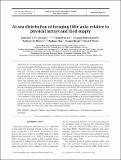Files in this item
At-sea distribution of foraging little auks relative to physical factors and food supply
Item metadata
| dc.contributor.author | Hovinen, J.E.H. | |
| dc.contributor.author | Welcker, J. | |
| dc.contributor.author | Rabindranath, A. | |
| dc.contributor.author | Brown, Z.W. | |
| dc.contributor.author | Hop, H. | |
| dc.contributor.author | Berge, J. | |
| dc.contributor.author | Steen, H. | |
| dc.date.accessioned | 2019-04-28T23:36:31Z | |
| dc.date.available | 2019-04-28T23:36:31Z | |
| dc.date.issued | 2014-04-29 | |
| dc.identifier | 145961060 | |
| dc.identifier | 84378778-5cf7-4d6a-acd1-6262c9a8c592 | |
| dc.identifier | 84901218360 | |
| dc.identifier | 000335581700018 | |
| dc.identifier.citation | Hovinen , J E H , Welcker , J , Rabindranath , A , Brown , Z W , Hop , H , Berge , J & Steen , H 2014 , ' At-sea distribution of foraging little auks relative to physical factors and food supply ' , Marine Ecology Progress Series , vol. 503 , pp. 263-277 . https://doi.org/10.3354/meps10740 | en |
| dc.identifier.issn | 0171-8630 | |
| dc.identifier.uri | https://hdl.handle.net/10023/17600 | |
| dc.description.abstract | Oceanographic processes and bathymetric features that consistently aggregate prey are often thought to be the main cues used by planktivorous birds to detect suitable foraging habitat. In this study we aimed to establish the main factors determining the at-sea distribution of the little auk Alle alle, a very abundant seabird in the Arctic during the chick-rearing period. Multiyear data from vessel-based bird counts along the west coast of Spitsbergen were compared with hydro-acoustic prey estimates (top 30 m water layer), bathymetry, and sea surface temperature (SST) at 2 spatial scales: fine- (3 km) and meso-scale (12 km). Acoustic data for the top 10 m water layer was omitted due to excess noise. However, the amount of prey in the upper layer was assumed to be reflected by the prey in the deeper (20 to 30 m) layer because of the unsynchronized diel vertical migration performed by zooplankton under midnight sun conditions. We found that the foraging distribution of little auks was mainly restricted to the continental shelf, presumably due to high availability of Arctic zooplankton there. Also, little auks preferred habitat characterized by low SST and flat sea-bottom. Such areas are likely to contain the preferred prey species of little auks, given that Arctic zooplankton distribution is linked to cold ocean temperatures. The number of little auks at sea increased with increasing abundance of macrozooplankton, but was not correlated with their preferred mesozooplankton prey. We conclude that physical features play an important role for the foraging habitat selection of little auks. Aggregations of macrozooplankton may be easier for the birds to detect than smaller-sized mesozooplankton and may be more important for adult little auks than previously thought. | |
| dc.format.extent | 15 | |
| dc.format.extent | 3112026 | |
| dc.language.iso | eng | |
| dc.relation.ispartof | Marine Ecology Progress Series | en |
| dc.subject | Alle alle | en |
| dc.subject | Spatial distribution | en |
| dc.subject | Zooplankton | en |
| dc.subject | Sea surface temperature | en |
| dc.subject | Foraging | en |
| dc.subject | QH301 Biology | en |
| dc.subject.lcc | QH301 | en |
| dc.title | At-sea distribution of foraging little auks relative to physical factors and food supply | en |
| dc.type | Journal article | en |
| dc.contributor.institution | University of St Andrews. School of Biology | en |
| dc.identifier.doi | https://doi.org/10.3354/meps10740 | |
| dc.description.status | Peer reviewed | en |
| dc.date.embargoedUntil | 2019-04-29 |
This item appears in the following Collection(s)
Items in the St Andrews Research Repository are protected by copyright, with all rights reserved, unless otherwise indicated.

